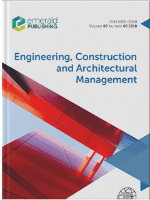
Engineering Construction and Architectural Management
Scope & Guideline
Leading the Charge in Engineering and Construction Research
Introduction
Aims and Scopes
- Project Management in Construction:
Focuses on methodologies and frameworks for effective project management, including risk management, scheduling, and resource allocation to enhance project outcomes. - Digital Technologies and Innovation:
Explores the integration of digital technologies such as Building Information Modeling (BIM), artificial intelligence, machine learning, and blockchain in construction processes to improve efficiency and sustainability. - Sustainability and Environmental Impact:
Investigates sustainable practices, green building technologies, and the environmental impact of construction activities, promoting eco-friendly approaches within the industry. - Human Factors and Organizational Behavior:
Examines the influence of human behavior, team dynamics, and leadership on project performance, safety, and worker well-being in the construction environment. - Policy and Regulatory Frameworks:
Analyzes the impact of policies, regulations, and governance structures on construction practices, aiming to improve compliance and ethical standards. - Collaboration and Stakeholder Engagement:
Focuses on the importance of collaboration among various stakeholders in construction projects, including contractors, clients, and communities, to enhance project success. - Emerging Trends and Technologies:
Addresses the latest trends in construction technologies and methodologies, including offsite construction, modular building, and smart construction practices.
Trending and Emerging
- Digital Transformation in Construction:
A significant increase in research focusing on the adoption of digital technologies such as BIM, IoT, and AI to streamline construction processes and enhance project delivery. - Sustainability in Construction Practices:
Growing emphasis on sustainable construction practices, including green building certifications and the use of eco-friendly materials, driven by global sustainability goals. - Health and Safety Management:
Increased focus on health and safety management, particularly in light of challenges posed by the COVID-19 pandemic, highlighting the importance of worker well-being and safety protocols. - Collaborative Approaches and Stakeholder Engagement:
Emerging trends in collaborative project delivery methods, such as Integrated Project Delivery (IPD) and public-private partnerships (PPPs), emphasizing stakeholder involvement and shared responsibilities. - Risk Management and Resilience:
Heightened interest in advanced risk management strategies and resilience planning to cope with uncertainties and disruptions in construction projects. - Social Sustainability and Community Engagement:
Growing research on the social aspects of construction, including community engagement and the social impacts of construction projects on local populations.
Declining or Waning
- Traditional Construction Methods:
Research on conventional construction methods and techniques has diminished as the industry increasingly shifts towards innovative practices and technologies. - Basic Project Management Skills:
Focus on fundamental project management skills has declined, as the field evolves to emphasize advanced methodologies and the integration of technology. - Single-Disciplinary Approaches:
Studies that focus solely on one discipline, such as civil engineering or architecture, are becoming less prevalent as interdisciplinary approaches gain importance in addressing complex construction challenges. - Non-Digital Communication Methods:
Research on non-digital communication strategies in project management has decreased, as digital tools and platforms become the norm for enhancing collaboration and information sharing.
Similar Journals

Organization Technology and Management in Construction
Unlocking the potential of construction through shared knowledge.Organization Technology and Management in Construction is a prominent open-access journal dedicated to advancing knowledge in the fields of building and construction, civil and structural engineering, and the management of technology and innovation. Published by SCIENDO, this journal has established itself as a vital platform for researchers, professionals, and students since its inception in 2016, providing unrestricted access to cutting-edge research that drives the industry forward. With an impressive quartile ranking of Q2 in both Building and Construction and Civil and Structural Engineering, alongside respectable positions in various management categories, the journal serves as a critical resource for those seeking to explore innovative management approaches and technological advancements in construction. The journal's commitment to open access reflects a dedication to disseminating knowledge widely, ensuring that all stakeholders in the field can benefit from the latest developments. Operating out of Warsaw, Poland, the journal aims to foster collaboration and discourse among a diverse community of scholars and practitioners, playing an essential role in shaping the future of construction management.
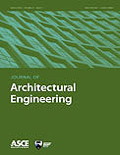
Journal of Architectural Engineering
Transforming Ideas into Architectural RealitiesThe Journal of Architectural Engineering, published by the ASCE (American Society of Civil Engineers), stands as a pivotal resource in the interdisciplinary fields of architecture and engineering. With an ISSN of 1076-0431 and E-ISSN 1943-5568, this journal has garnered a notable reputation since its inception in 1995, currently converging towards 2024. Boasting a Q1 ranking in Architecture and Visual Arts and Performing Arts, alongside respectable Q3 rankings in Building and Construction and Civil and Structural Engineering, the journal places itself in the elite class of scholarly publications, evidenced by its impressive Scopus rankings. Its commitment to providing cutting-edge research ensures comprehensive coverage across various aspects of architectural engineering, facilitating robust interdisciplinary dialogues. Although the journal operates under a traditional access model, its impact on the academic community remains profound, making it an essential platform for researchers, professionals, and students who seek to push the boundaries of knowledge in their respective fields. This journal not only aims to stimulate innovative ideas but also fosters a collaborative environment for advancing sustainable architectural practices in a rapidly evolving built environment.
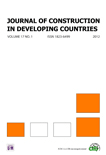
Journal of Construction in Developing Countries
Empowering Development through Scholarly InsightsThe Journal of Construction in Developing Countries, published by Penerbit Universiti Sains Malaysia, stands as a pivotal platform for disseminating vital research in the fields of construction, architecture, and civil engineering within the context of developing nations. With an ISSN of 1823-6499 and an E-ISSN of 1985-8329, this open-access journal has been dedicated to promoting the sharing of knowledge since 2006. Its significant contributions to the literature have earned it a respectable position in various categories as highlighted by its 2023 quartile rankings: Q2 in Architecture and Q3 in Building and Construction, Civil and Structural Engineering, as well as Strategy and Management. Researchers and professionals alike benefit from its expansive reach, as it engages with current challenges and innovations in the construction sector across developing regions. The journal's commitment to accessibility enhances its impact and encourages rigorous scholarly dialogue, making it an essential resource for those looking to navigate the complexities of urban development and infrastructure management.
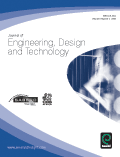
Journal of Engineering Design and Technology
Shaping the Future of Engineering with Insightful ResearchJournal of Engineering Design and Technology, published by Emerald Group Publishing Ltd, is a prominent platform in the field of engineering, specializing in design and technology innovations. With an ISSN of 1726-0531, this journal has made significant contributions to the body of knowledge since its inception in 2005, offering rigorous peer-reviewed articles that cover a diverse range of topics from conceptual design to advanced engineering practices. As a Q2 journal in Engineering (miscellaneous), it stands out in the Scopus Rankings with a commendable position at #44 out of 307 and an impressive 85th percentile, reflecting its substantial impact in the engineering community. While currently not categorized as Open Access, the journal continues to pursue accessibility and engagement for researchers, professionals, and students alike, ensuring that influential research is disseminated effectively. As it converges towards 2024, the Journal of Engineering Design and Technology remains an essential resource for those advancing the scope of engineering innovations and technology-driven solutions.
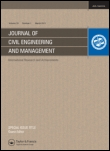
Journal of Civil Engineering and Management
Transforming ideas into impactful engineering solutions.Journal of Civil Engineering and Management, published by Vilnius Gediminas Technical University in Lithuania, is a prominent open access journal dedicated to the dissemination of cutting-edge research in both civil and structural engineering as well as strategic management. With the ISSN 1392-3730 and E-ISSN 1822-3605, this journal has been an essential resource for academics and industry professionals since its inception in 2002 and has continued through to 2024. Recognized for its high-quality publications, it ranks in the Q2 quartile in both the fields of Civil and Structural Engineering and Strategy and Management, reflecting its significant impact in the academic community with a Scopus ranking of #75 out of 379 and #121 out of 478 respectively. The journal embraces an open-access model, promoting wider distribution and accessibility of knowledge to foster innovation and collaborative advancements in construction practices and management strategies. It serves as a vital platform for researchers, professionals, and students looking to contribute to and stay informed about the latest developments in these dynamic fields.
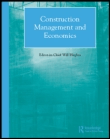
Construction Management and Economics
Elevating academic discourse in construction economics.Construction Management and Economics, established in 1983 and published by Routledge Journals, Taylor & Francis Ltd, is a premier academic journal that serves as a vital resource for professionals and researchers in the fields of construction management and economics. With an impressive 2023 impact factor reflected in its Q1 category rankings in Building and Construction, Industrial and Manufacturing Engineering, and Management Information Systems, the journal consistently publishes rigorous and influential research that shapes industry practices and academic thought. Addressing crucial topics from project management to economic evaluations within the construction sector, the journal offers an ideal platform for scholarly discourse and innovative research methodologies. Recognized for its high-quality content, it has established itself as a leading publication with notable Scopus rankings, ensuring that your work will reach a broad, specialized audience. Participants in construction-related fields can greatly benefit from the insights shared within these pages, while the absence of open access further emphasizes the journal's commitment to maintaining an academic standard that facilitates comprehensive peer review.

Journal of Information Technology in Construction
Empowering the Future of Construction with KnowledgeThe Journal of Information Technology in Construction is a premier open-access journal dedicated to advancing knowledge in the intersection of information technology and construction practices. Established in 1996, this journal has emerged as a vital resource for researchers, professionals, and students in the fields of Building and Construction, Civil and Structural Engineering, and Computer Science Applications. Published by the INT COUNCIL RESEARCH & INNOVATION BUILDING & CONSTRUCTION, this journal's rigorous peer-reviewed content is designed to foster innovation and enhance the application of technological solutions within the construction sector. With a commendable reputation, the journal has secured Q1 ranking in Building and Construction and features in the top quartiles in related disciplines, ensuring its impact and relevance within academic and industrial communities. Conveniently accessible, the journal showcases high-quality research that influences both theoretical and practical aspects of construction technology, thereby contributing significantly to the field. Based in Sweden, the Journal of Information Technology in Construction stands as a crucial platform for disseminating insights that drive progress in this dynamic and evolving domain.
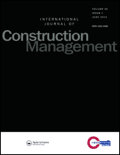
International Journal of Construction Management
Exploring Best Practices in Construction ExcellenceInternational Journal of Construction Management, published by TAYLOR & FRANCIS LTD, is a premier academic journal that caters to the evolving field of construction management and its associated disciplines. With an ISSN of 1562-3599 and an E-ISSN of 2331-2327, this journal is distinguished by its outstanding performance, ranking in Q1 across multiple categories including Architecture, Building and Construction, and Management of Technology and Innovation as of 2023. The journal's significant impact is reflected in its Scopus ranks, notably placing 4th in Architecture and 25th in the Building and Construction category, demonstrating its critical role in advancing both academic research and practical applications in the construction sector. With a timeline of convergence from 2009 to 2024, the journal provides a platform for innovative research, case studies, and reviews that align with industry trends and challenges. Researchers, practitioners, and students are encouraged to explore the journal's invaluable contributions to the discourse in construction management, fostering a deeper understanding of best practices, technologies, and strategies essential for the industry's future.
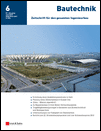
Bautechnik
Building bridges between research and practice in engineering.Bautechnik is a premier academic journal in the fields of Building and Construction and Civil and Structural Engineering, published by ERNST & SOHN in Germany. With a history dating back to 1969 and a significant converged timeline through various years, this journal offers a rich repository of peer-reviewed research dedicated to advancing the principles, methodologies, and innovations within its domains. Bautechnik is currently ranked in the Q3 category for both building and construction, as well as civil and structural engineering, indicating its relevance and contribution to the academic community. Though it does not offer open access, its curated content is accessible to a global audience of researchers, professionals, and students striving for excellence in their fields. The journal aims to foster discussions and disseminate knowledge that impacts the future of construction, architecture, and engineering practices.
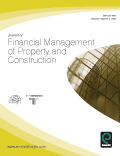
Journal of Financial Management of Property and Construction
Exploring the Future of Financial Management in Construction.The Journal of Financial Management of Property and Construction, published by Emerald Group Publishing Ltd, is a premier academic journal dedicated to advancing knowledge in the financial management practices specific to the property and construction sectors. With an ISSN of 1366-4387 and an E-ISSN of 1759-8443, this journal aims to bridge the gap between theoretical frameworks and practical applications, making it an essential resource for researchers, professionals, and students interested in these dynamic fields. The journal's impact is reflected in its 2023 category quartiles, ranking Q3 in Accounting, Q2 in Business and International Management, and Q3 in Economics and Econometrics, underscoring its relevance across multiple disciplines. With a converged publication period from 2005 to 2024, it continues to publish high-quality research that addresses contemporary challenges and innovative strategies within the industry. By prioritizing impactful research and practical insights, the Journal of Financial Management of Property and Construction stands at the forefront of scholarly conversation, fostering the ongoing development and refinement of best practices in the financial management of property and construction.